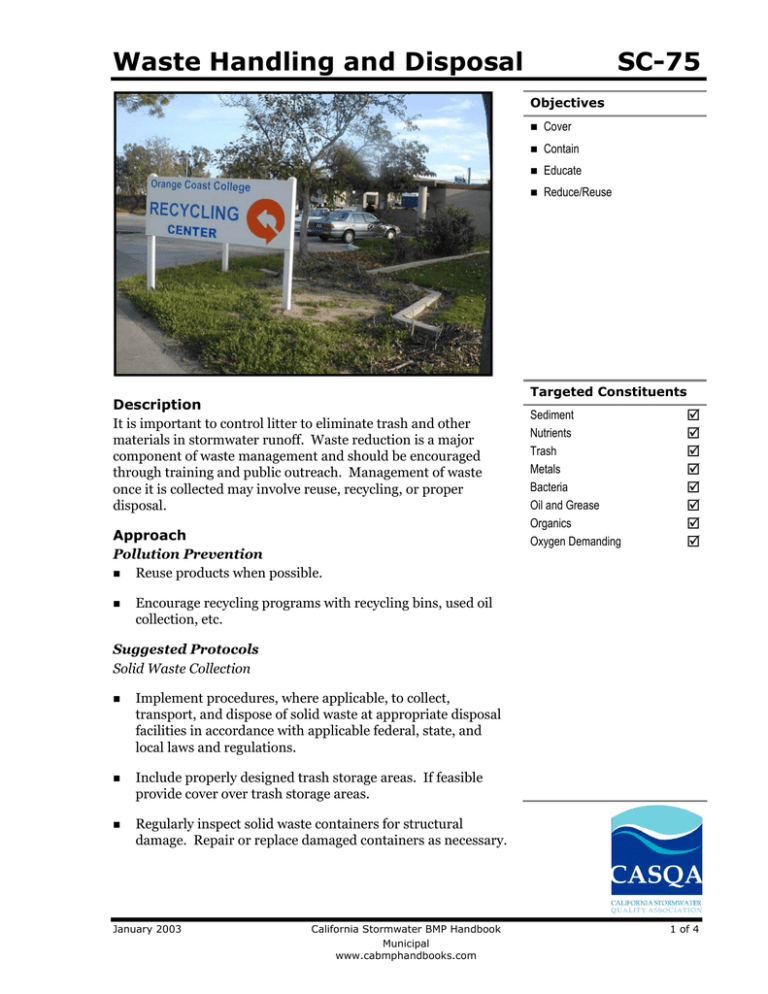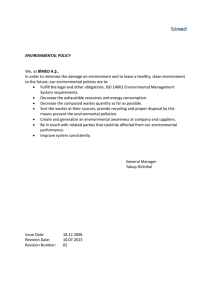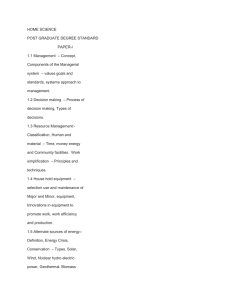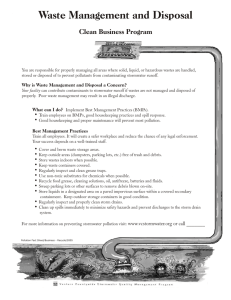Waste Handling and Disposal SC-75
advertisement

Waste Handling and Disposal SC-75 Objectives Description It is important to control litter to eliminate trash and other materials in stormwater runoff. Waste reduction is a major component of waste management and should be encouraged through training and public outreach. Management of waste once it is collected may involve reuse, recycling, or proper disposal. Approach Pollution Prevention Reuse products when possible. Cover Contain Educate Reduce/Reuse Targeted Constituents Sediment Nutrients Trash Metals Bacteria Oil and Grease Organics Oxygen Demanding ; ; ; ; ; ; ; ; Encourage recycling programs with recycling bins, used oil collection, etc. Suggested Protocols Solid Waste Collection Implement procedures, where applicable, to collect, transport, and dispose of solid waste at appropriate disposal facilities in accordance with applicable federal, state, and local laws and regulations. Include properly designed trash storage areas. If feasible provide cover over trash storage areas. Regularly inspect solid waste containers for structural damage. Repair or replace damaged containers as necessary. January 2003 California Stormwater BMP Handbook Municipal www.cabmphandbooks.com 1 of 4 SC-75 Waste Handling and Disposal Secure solid waste containers; containers must be closed tightly when not in use. Do not fill waste containers with washout water or any other liquid. Ensure that only appropriate solid wastes are added to the solid waste container. Certain wastes such as hazardous wastes, appliances, fluorescent lamps, pesticides, etc. may not be disposed of in solid waste containers (see chemical/ hazardous waste collection section below). Do not mix wastes; this can cause chemical reactions, make recycling impossible, and complicate disposal. Refer to SC-34 Waste Handling and Disposal for more information regarding solid waste facilities. Waste Reduction and Recycling Recycle wastes whenever possible. Many types of waste can be recycled, recycling options for each waste type are limited. All gasoline, antifreeze, waste oil, and lead-acid batteries can be recycled. Latex and oil-based paint can be reused, as well as recycled. Materials that cannot be reused or recycled should either be incinerated or disposed of at a properly permitted landfill. Recycling is always preferable to disposal of unwanted materials. Recycling bins for glass, metal, newspaper, plastic bottles and other recyclable household solid wastes should be provided at public facilities and/or for residential curbside collection. Controlling Litter Post “No Littering” signs and enforce anti-litter laws. Provide litter receptacles in busy, high pedestrian traffic areas of the community, at recreational facilities, and at community events. Clean out and cover litter receptacles frequently to prevent spillage. Illegal Dumping Substances illegally dumped on streets and into the storm drain system and creeks include paints, used oil and other automotive fluids, construction debris, chemicals, fresh concrete, leaves, grass clipping, and pet wastes. Post “No Dumping” signs with a phone number for reporting dumping and disposal. Signs should also indicate fines and penalties for illegal dumping. Landscaping and beautification efforts of hot spots might also discourage future dumping. See SC-74 Drainage System Maintenance, and SC-10 Non-Stormwater Discharges. 2 of 4 California Stormwater BMP Handbook Municipal www.cabmphandbooks.com January 2003 Waste Handling and Disposal SC-75 Requirements Costs The costs for a solid waste source control program vary depending on the type of method. The cost of a community education program or a plan to increase the number of trash receptacles can be very minimal. Costs for structural controls such as trash racks, bar screens, and silt traps can be quite costly ranging from $250,000 to $900,000. A collection facility or curbside collection for used oil may result in significant costs. Commercial locations (automobile service stations, quick oil change centers, etc.) as collection points eliminate hauling and recycling costs. Collection and disposal of hazardous waste can be very expensive and requires trained operators; laboratory and detection equipment; and extensive record keeping including dates, types, and quantities. Use of volunteer work forces can lower storm drain stenciling program costs. Stenciling kits require procurement of durable/disposable items. The stenciling program can aid in the cataloging of the storm drain system. One municipality from the state of Washington has estimated that stenciling kits cost approximately $50 each. Stencils may cost about $8 each including the die cost on an order of 1,000. Re-orders cost about $1/stencil. Stencil designs may be available from other communities. Stencil kits should be provided on a loan basis to volunteer groups free of charge with the understanding that kit remnants are to be returned. Maintenance The primary staff demand for stenciling programs is for program setup to provide marketing and training. Ongoing/follow-up staff time is minimal because of volunteer services. Staffing requirements are minimal for oil recycling programs if collection/recycling is contracted out to a used oil hauler/recycler or required at commercial locations. Staff requirements for maintaining good housekeeping BMPs at waste handling sites is minimal. Supplemental Information Further Detail of the BMP Waste Reduction An approach to reduce stormwater pollution from waste handling and disposal is to assess activities and reduce waste generation. The assessment is designed to find situations where waste can be eliminated or reduced and emissions and environmental damage can be minimized. The assessment involves collecting process specific information, setting pollution prevention targets, and developing, screening and selecting waste reduction options for further study. Starting a waste reduction program is economically beneficial because of reduced raw material purchases and lower waste disposal fees. January 2003 California Stormwater BMP Handbook Municipal www.cabmphandbooks.com 3 of 4 SC-75 Waste Handling and Disposal References and Resources Best Management Practices Program for Pollution Prevention, City and County of San Francisco, Uribe & Associates, Oakland, California, 1990. Harvard University. 2002. Solid Waste Container Best Management Practices – Fact Sheet OnLine Resources – Environmental Health and Safety. Model Urban Runoff Program: A How-To-Guide for Developing Urban Runoff Programs for Small Municipalities. Prepared by City of Monterey, City of Santa Cruz, California Coastal Commission, Monterey Bay National Marine Sanctuary, Association of Monterey Bay Area Governments, Woodward-Clyde, Central Coast Regional Water Quality Control Board. July 1998. (Revised February 2002 by the California Coastal Commission). Orange County Stormwater Program http://www.ocwatersheds.com/StormWater/swp_introduction.asp. Santa Clara Valley Urban Runoff Pollution Prevention Program. 1997 Urban Runoff Management Plan. September 1997, updated October 2000. 4 of 4 California Stormwater BMP Handbook Municipal www.cabmphandbooks.com January 2003





